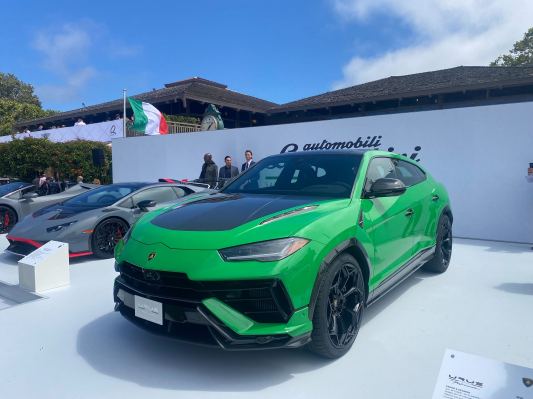EV acceleration hit a new and interesting phase at the Monterey Car Week event that wrapped Sunday.
Kia, (yeah Kia) showed up at the typically ultra-luxe affair with its EV6 GT, a new performance trim that will go on sale by the end of the year and can travel from zero to 60 miles per hour in just 3.4 seconds. This isn’t a hypercar or even a sports car — yet it’s capable of leaving both types of vehicle in the dust.
This increasingly common scenario puts supercar makers like Lamborghini in a weird spot. And it’s a spot Lamborghini is well aware of, according to the company CTO Rouven Mohr, who spoke to TechCrunch during the event.
With EV powertrains providing quicker off-the-line metrics, Lamborghini has realized that the sprint to highway speed is no longer a major goal. For instance, Lamborghini unveiled during Monterey Car Week its Urus Performante, a luxury internal combustion engine SUV that outperforms the Kia EV6 GT by a mere one-tenth of a second.
Lamborghini is taking a different tactic than pure power, even if its EV plans are not entirely settled, TechCrunch learned. Mohr said the automaker is doubling down on the experience, as well as the company’s history of making unexpected product moves.
“I can tell you that there are a few brands in the automotive sector where you can do a, let’s call it ‘crazy thing,'” Mohr said, adding that Lamborghini has had success with its unconventional actions. The Lamborghini Countach, the supercar that created the look of the supercar, is one example. Another, is the Urus. The super SUV could have turned off purists. Instead, it has become the best-selling Lamborghini ever.
Those moments might be risky, but it has also given Lamborghini a certain degree of freedom that other automakers don’t enjoy.
In the past 15 to 20 years, the company has gone from a pure numbers vehicle to a driver’s car, Mohr noted. With the rise of electric vehicles, that’s becoming a smarter, some might say, required, position.
“You can have a car that is extremely fast, but boring. This is not our intention. Our mission is for the driver to jump out of the car with a smile,” Mohr said.
The zero-to-60 battles don’t impress Mohr, in part, he said, because it’s not that fun and it can make some people sick. “In reality, it’s irrelevant, to be honest,” Mohr said.
Mohr points to the new Urus Performante as an example. No one complained that the original Urus was too slow, he said. And while the new version is quicker, the focus should be on how the new variant of the supercar SUV feels, he contends.
In the electric world, Mohr says that power is free, more or less. It’s not a differentiating factor in the future because every car will be able to accelerate quickly at the expense of range. To Mohr, Lamborghini has to offer one dimension more to customers, “we have to bring the reactiveness of the car to the next level.”
Mohr sees the instant access of torque to all four wheels, which is not possible in a gas-powered vehicle, as the key to building EV supercars. He noted that the Porsche Taycan and Audi E-Tron GT are both examples of this type of engineering. But for a Lamborghini, it has to be at a higher level.
Lamborghini’s LDVI system (Lamborghini Dinamica Veicolo Integrata), which adjusts torque and steering based on traction and what the vehicle believes the driver is attempting to accomplish, is one such feature, Mohr noted. It will continue to evolve as it’s placed in vehicles with electric powertrains. It will be able to react and adjust much quicker in an electric vehicle.
“I see a lot of potential,” Mohr said. “I’m very, very excited in the next few years to develop in this direction and I think this will open up a completely new field.”
